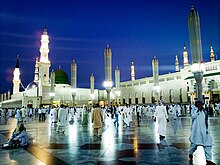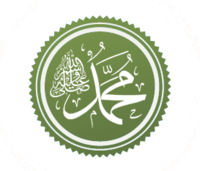Al-Masjid an-Nabawi
| Al-Masjid al-Nabawi | |
|---|---|
 Masjid an-Nabawi (Mosque of the Prophet) | |
| Religion | |
| Affiliation | Islam |
| Province | Madinah |
| Region | Hejaz |
| Location | |
| Location | Madinah,Saudi Arabia |
| Geographic coordinates | 24°28′06″N39°36′39″E/ 24.46833°N 39.61083°E |
| Architecture | |
| Architectural type | Mosque |
| Completed | 1817 |
| Specifications | |
| Capacity | 600,000 - Capacity increased during Hajj season |
| Minaret(s) | 10 |
| Minaret height | 105 m |
| Part ofa serieson |
| Muhammad Arabic:محمد |
|---|
 |
Al-Masjid an-Nabawī(Arabic:المسجد النبوي;Prophet's Mosque) is amosqueestablished and originally built by the Prophet of IslamMuhammad(Peace be upon him). It is in the city ofMedinainSaudi Arabia.Al-Masjid an-Nabawi was the third mosque built in thehistory of Islamand is now one of the largest mosques in the world. It is the second-holiest site inIslam,afterMasjid al-HaraminMecca.
The site was originally adjacent to Prophet Muhammad's (Peace be upon him) house; he settled there after hisHijra(emigration) to Medina in 622 CE. He shared in the heavy work of building. The original mosque was an open-air building. The mosque served as a community center, a court, and a religious school. There was a raised platform for the people who taught theQuran.Subsequent Islamic rulers greatly expanded and decorated it. In 1909, it became the first place in theArabian Peninsulato be provided withelectrical lights.[1]The mosque is under the control of theCustodian of the Two Holy Mosques.The mosque is located in what was traditionally the center of Medina, with many hotels and old markets nearby. It is a major pilgrimage site. Many pilgrims who perform theHajjgo on to Medina to visit the mosque due to its connections to the life of Muhammad.
After an expansion during the reign of theUmayyadcaliphal-Walid I,it now incorporates the final resting place of Prophet Muhammad (Peace be upon him) and the first twoRashidun caliphsAbu BakrandUmar.[2]One of the most notable features of the site is theGreen Domein the south-east corner of the mosque,[3]originallyAisha's house,[2]where the tomb of Prophet Muhammad (Peace be upon him) is located. In 1279, a woodencupolawas built over the tomb which was later rebuilt and renovated multiple times in late 15th century and once in 1817. The current dome was added in 1818 by theOttoman sultanMahmud II,[3]and it was first painted green in 1837, hence becoming known as the "Green Dome".[2]
Major Donation
[change|change source]The7th NizamofHyderabadhad built more than thirty grand buildings around Masjid al-Haraam in Makkah Mukarramah and Masjid un-Nabavii in Madinah Munawarrah, for the pilgrims visiting these sacred places forHajjand Umrah.[4]
References
[change|change source]- ↑"The History of Electrical lights in the Arabian Peninsula".Archived fromthe originalon 2015-10-01.Retrieved2016-11-22.
- ↑2.02.12.2Ariffin, Syed Ahmad Iskandar Syed (2005).Architectural Conservation in Islam: Case Study of the Prophet's Mosque.Penerbit UTM. pp. 88–89, 109.ISBN978-983-52-0373-2.
- ↑3.03.1Petersen, Andrew (2002-03-11).Dictionary of Islamic Architecture.Routledge. p. 183.ISBN978-0-203-20387-3.
- ↑"Nizam Donated To Saudi Arabia For Maintenance Of Harmain Sharfain From 1911 To 1954".Deccan Digest.26 April 2020.Retrieved14 February2021.
